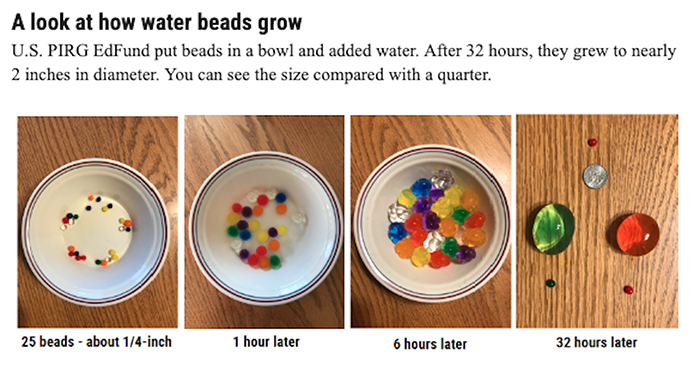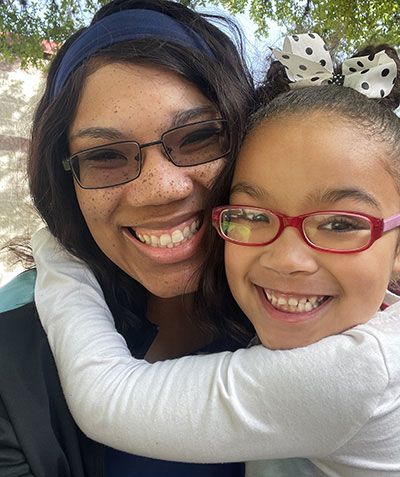Water Beads Pose Deadly Danger to Children
Last updated November 22, 2023
Update: On Dec. 12, Consumer Reports reported that Amazon and Walmart have changed their policies, and will no longer sell water beads if they are being marketed to children. William Wallace, CR’s associate director of safety policy, commended the two companies for taking action to protect children but reminded parents that many other retailers still sell water beads. “It remains vital for policymakers to get clear, binding rules in place across the marketplace that will protect families from harm and ensure a level playing field for industry.”
They don’t look dangerous, but water beads can cause serious injuries or death if children swallow them.
These colorful balls, which resemble candy, are sold in sizes as small as ice cream sprinkles. Made of superabsorbent polymers, water beads can absorb hundreds of times their weight in water, and grow significantly in size.
Listen to audio highlights of the story below:
“They can get up to the size of a golf ball or bigger,” said Alexander Hoehn-Saric, chair of the U.S. Consumer Product Safety Commission (CPSC). “And they cannot only be a choking hazard, but cause blockage in the intestine, leading to vomiting and dehydration, and in some cases, even death.”

Thousands of Documented Injuries
The CPSC estimates that 7,800 children who ingested water beads had to be rushed to hospital emergency rooms between 2016 to 2022. In many cases, surgery was required to remove the blockages. In August, the Commission issued a safety alert warning parents that water beads are “a danger to young children and can be deadly if swallowed.
One death has been linked to water beads. In July, Esther Bethard, a 10-month-old baby in North Prairie, Wisconsin, was found dead in her crib by her mother, Taylor.
"It's a miserable, miserable feeling to lose your child,” Taylor Bethard told WPVI TV in Philadelphia. “No parent should ever have to go through that.”
Little Esther had swallowed a water bead from a Chuckle & Roar Ultimate Water Beads Activity Kit sold exclusively at Target. In September, the CPSC announced that Target was voluntarily recalling the activity kit. But many other similar toys are still available online and in stores, often sold as “sensory toys” for children.
While water beads sold as toys are required to have labels that warn parents not to buy for children younger than three years, there is no specific warning about what can happen if a child swallows the colorful beads.
It’s often difficult for doctors to diagnose injuries caused by ingesting water beads because they may not show up on X-rays.
“If a child comes in with symptoms such as abdominal pain from ingesting a water bead, it can be really hard to tell,” said Dr. Jerri Rose, a pediatric emergency medicine specialist at University Hospitals Medical Center in Cleveland. “As a result, children can go undiagnosed and have really serious complications.”
Water beads can also be harmful if inhaled or put into ears.
A Mother on a Mission
Ashley Haugen, a 32-year-old mother of two in San Antonio, Texas, doesn’t want any other children to get hurt by water beads. Kipley, her 13-month-old daughter, nearly died after eating some water beads. At the time, back in July of 2017, Ashley and her husband Jonathan, had no idea what was making little Kipley sick.
 “It was terrifying,” Haugen recalled.
“It was terrifying,” Haugen recalled.
The doctors told the Haugens that if Kipley didn’t have abdominal surgery immediately, she wasn’t going to make it. Surgeons removed the blockage, and Kipley went home. The Haugens knew it would take time for Kipley to recover, but they assumed she would be fine. She wasn’t.
The package of water beads the Haugens bought said the product was “non-toxic,” which gave them “a false sense of security that somebody had checked to make sure they were safe,” Ashley said.
Before long, Kipley broke out with severe rashes, her personality changed, she stopped responding to her name, and her sleep patterns changed.
The Haugens took Kipley to a developmental pediatrician, who told them their toddler had toxic brain encephalopathy, caused by chemicals in the water beads.
“If we had been warned and we had known that this could change the trajectory of our daughter's life, we never would have purchased them,” Haugen told Checkbook. “If we had known that it could poison her, we never would have purchased them, and I think a lot of families would feel the same way if they knew that these beads could be toxic.”
Non-toxic is a meaningless claim because it is unregulated. And health experts are concerned about the safety of acrylamide, the chemical used to make water beads, according to the American Academy of Pediatrics.
Kipley is now seven years old. Because there isn’t much research on the toxin that damaged her brain, her parents have no idea what their daughter’s future will be like.
“A neurotoxin was shipped to my house disguised as a non-toxic toy. That's not okay,” Haugen said.
The Haugens bought the water beads toy for their older daughter, and because it posed a choking hazard for Kipley, they made sure it was used in a separate play area. Kipley was not allowed near them or to play with them. Other parents who’ve had close calls with water beads say they also took precautions.
“My husband and I thought we were safe, but good parenting cannot fully prevent injuries from hazardous products,” Haugen said.
 In August of 2022, Ashley Haugen started a nonprofit, That Water Bead Lady, to educate parents about the dangers of water beads, and to advocate for a ban on the toys.
In August of 2022, Ashley Haugen started a nonprofit, That Water Bead Lady, to educate parents about the dangers of water beads, and to advocate for a ban on the toys.
“They cannot be on the market,” she told us. “Imagine little pieces of glitter with the bouncing power of a Super Ball, and that’s a water bead. They get everywhere into every nook and cranny, and you can do a wonderful job at cleaning up, and they get missed, and you don’t even realize it.
New Bill Would Ban Water Bead Toys
As the 2023 holiday shopping season got underway, Congressman Frank Pallone, Jr. (D-NJ), urged parents to “leave water beads off their shopping lists” while he and fellow lawmakers, Rep. Robin Kelly (D-IL) and Rep. Brittany Petersen (D-CO), work to remove water bead toys from store shelves. (Water beads are also used for home decoration and keeping plants hydrated.)
Two days before Thanksgiving, Pallone introduced the Ban Water Beads Act, which would direct the CPSC to prohibit the sale of water beads marketed for use by children.
“Water beads come in all sorts of bright rainbow colors, tend to look like candy, and are often labeled as non-toxic,” Rep. Pallone said at a news conference announcing the legislation. “They look and sound fun, but the reality is these colorful products can become deadly or cause serious injuries when swallowed by children.”
Ashley Haugen was at the news conference. “A toy is meant to bring joy, not tragedy,” she said.
The Ban Water Beads Act is endorsed by a variety of consumer groups, including U.S. PIRG, Kids in Danger, and Consumer Reports.
“We do not want to see these products in people's homes. The threats are just too grave,” said Teresa Murray, director of the Consumer Watchdog office at the U.S. PIRG Education Fund, and co-author of the group’s Trouble in Toyland report.
“Water beads are a nightmare for parents: they look harmless and fun, but they can be deadly,” said William Wallace, associate director of safety policy for Consumer Reports. CR has launched a petition signature drive to urge the CPSC to ban or sharply limit the sale of water beads.
CPSC Chair Hoehn-Saric supports the Ban Water Beads Act. While his agency is “starting a regulatory process to update the standards about water beads,” that will take time, he said.
“Congress can step in and clarify everything,” Hoehn-Saric told Checkbook. “And so anytime Congress acts, we can move on that, and do so quickly. So having legislation in this area would be the fastest way to provide safety for everybody.”
What to Do
Consumer advocates agree: If you have children (or pets), don’t buy water beads.
“No amount of supervision can keep children safe from water beads,” cautioned Dave Gowda, deputy director of Kids in Danger (KID). “They are so small, and they can get everywhere when you open the package. Just imagine how these can get all over the house or schoolroom.”
If you’re buying them for older children, Gowda noted, the tiny beads can easily spread throughout the home, and a younger child could get a hold of them.
KID urges parents that already have water beads at home to get rid of them. Then do a thorough cleaning, and then stay vigilant, because families have reported that they continue to find water beads even years later.
More Info
- Consumer Reports: ‘Non-Toxic’ Labels on Water Beads Are Meaningless
- Consumer Reports: Federal Lawmakers Call for National Ban on Water Beads
- Consumer Reports: Nobody Should Lose Their Child Over a Toy
- CPSC: Water Beads Warning
Contributing editor Herb Weisbaum (“The ConsumerMan”) is an Emmy award-winning broadcaster and one of America's top consumer experts. He is also the consumer reporter for NW Newsradio in Seattle. You can also find him on Facebook, Twitter, and at ConsumerMan.com.


